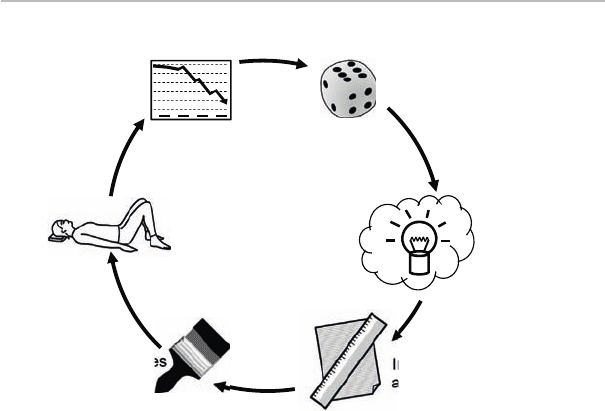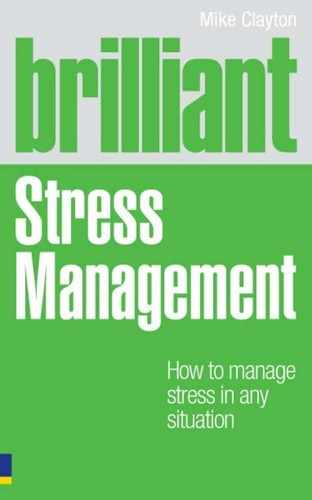
Manage stress caused by change 155
How you are programmed to respond to change
Figure 8.2 illustrates the emotional rollercoaster we all go
through when faced with imposed change that we perceive as
uncomfortable or threatening.
The rollercoaster of change
The curve in Figure 8.2 represents everyone’s experience of
change. What will differ – in often quite surprising ways – will
be the nature and intensity of the emotions different people will
feel, how they express them, and the pace at which they pass
through the stages. Consequently, two people may experience
the same situation quite differently and therefore feel quite dif-
ferent levels of stress. Let’s look at each stage in turn.
Stage 1: Denial
Our rst response to rst realising that change is happening is
usually denial. Our brains reject its discomforts and pretend it
© MikeClayton,2011
Moment of
insight
Investigation
and planning
Making changes
Inevitable
decline
Seemingly
random incident
Enjoying
the benefits
Figure 8.1 The change cycle

156 brilliant stress management
is not happening: before ght or ight comes fright. How often
have you found yourself saying ‘It will never happen’ or ‘It won’t
affect me’ when, in your heart of hearts, you know it will? In front
of others, we often dress it up as cynicism or scepticism, but we
are really sticking our head in the sand and hoping it will go away.
Stage 2: Emotion
When we can no longer deny the reality of change, our emo-
tional centres are the rst to react. Depending upon how we
perceive the change, our emotions can be strong or mild and of
many sorts, from sadness to grief, frustration to anger, bitter-
ness to disgust. They are a perfectly natural sign that the limbic
system of our brain is engaged, and looking for ways to protect
us, by triggering our ght-or-ight mechanisms.
Stage 1: Denial
Stage 4: Exploration
Stage 5: AcceptanceStage 3: Resistance
Stage 2: Emotion
Stage 6: Commitment
© MikeClayton,2011
Figure 8.2 The rollercoaster of change

Manage stress caused by change 157
There may also be a sense of relief and some positive emotions.
Here, however, we are focusing on changes that are perceived as
adverse or threatening – even if they are not really so.
When people start to get angry or upset about change, the last
thing you should do is try to reason with them: ‘There’s no point
in getting angry. Calm down and look at it rationally.’ This will just
make them more angry or upset. Instead, you must respect their
emotions and give them time to express them. The best thing
you can do is to listen to them uncritically.
Stage 3: Resistance
Eventually, the power of our emotions subsides and they are
replaced by reason. We start to become rational and start to
think through the situation. We rst tend to see the drawbacks
associated with the change, because we focus on what we are
losing, so this stage is characterised by a reasoned resistance to
change. If you are trying to promote the change, then encoun-
tering this resistance is daunting, because there will almost
certainly be pros and cons to the change, and now you have to
deal with rational opposition.
The good news is that rational
thinking allows us to analyse a situa-
tion and start to regain control. This
stage is where we can start to ght
the stress.
Stage 4: Exploration
Once we are thinking in a rational way, we can start to evaluate
the benets as well as costs of the change. This stage is often the
least energetic one, where we may feel frozen by inaction and
with minimum control. But it is the stage where we explore our
options and assess how to respond to the change. This choice
can give us control, and, when we make our decision, we can
seize control.
rational thinking
allows us to analyse a
situation and start to
regain control
158 brilliant stress management
Stage 5: Acceptance
Having made our choice consciously, the next stage is where it
sinks in, and we start to accept our new future. At the same time
we also take our rst steps to control our situation.
Stage 6: Commitment
The last stage of change is when we are fully committed to
making changes and are in control. This does not mean that we
like the change that has happened, but it does mean that we have
completely accepted that we cannot change it and are therefore
pursuing the next stage of our life.
A couple of examples
Let’s look at two very different examples: someone who has suf-
fered a bereavement, and someone whose employer changes the
way that they operate at work.
A bereavement
Often people’s rst response to hearing of a loss is to say ‘N o,
it can’t be.’ We want to wind the clock back and make things
different. This is denial. It is followed by a period of almost
pure emotion: grief. The next stage sees people rage against the
change, starting to consider the effects on them, their family
and their plans. This is a form of resistance, which is followed
by a quiet period of starting to come to terms with their loss.
This turns into acceptance, when we fully realise that the loss
is permanent. Only later do we start to move on with our lives
and make a commitment to a new life without the person we
have lost.
Without the acceptance and commitment, we cannot stop
grieving and the bereavement has triggered a long-term problem.
A change at work
‘They’ve been talking about this for years. It will never happen. They
wouldn’t dare’ eventually becomes ‘How dare they, good grief, oh
..................Content has been hidden....................
You can't read the all page of ebook, please click here login for view all page.
